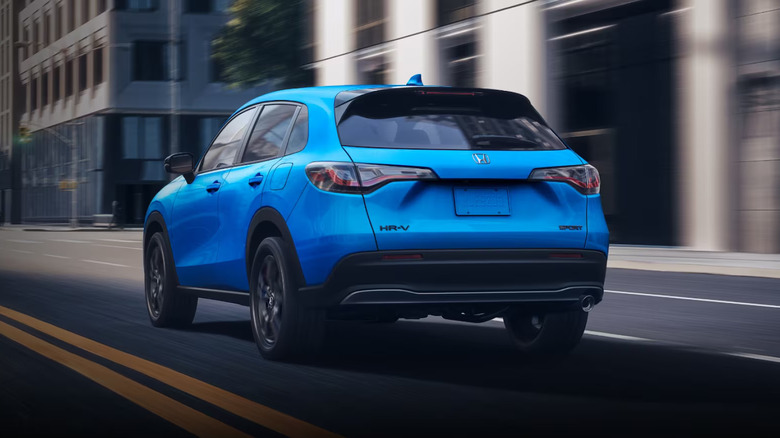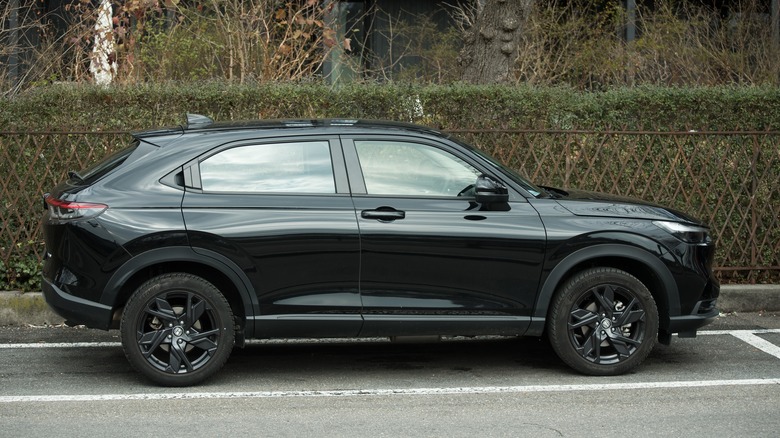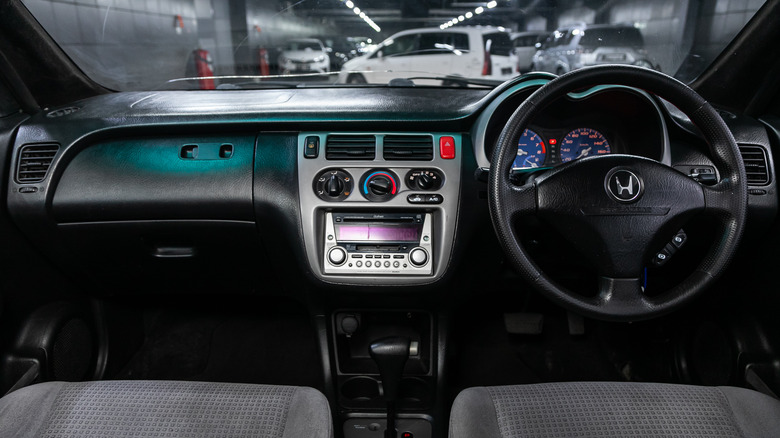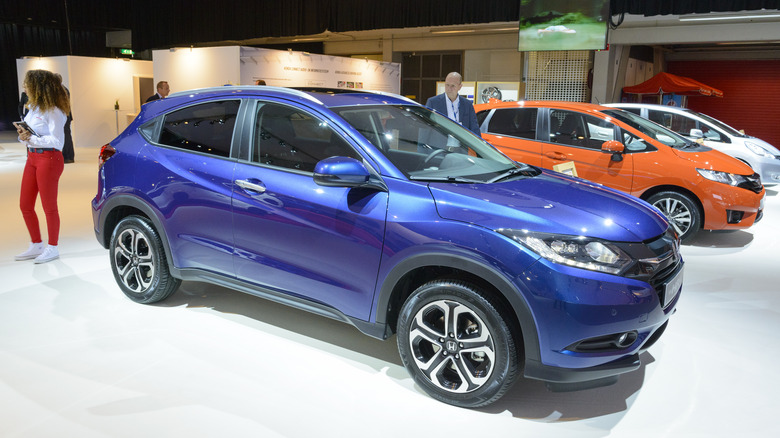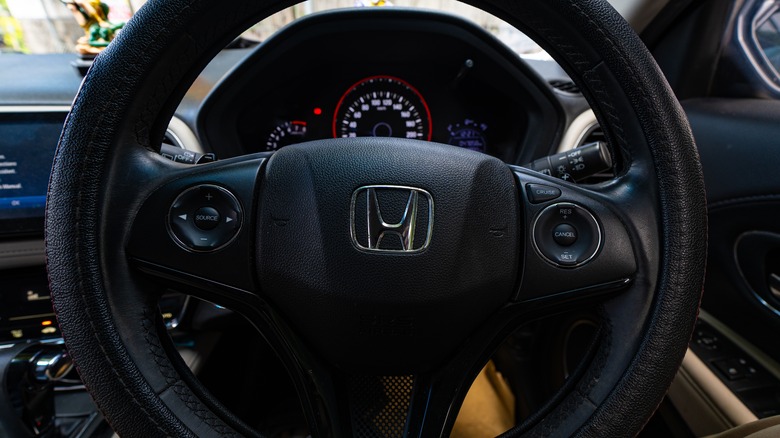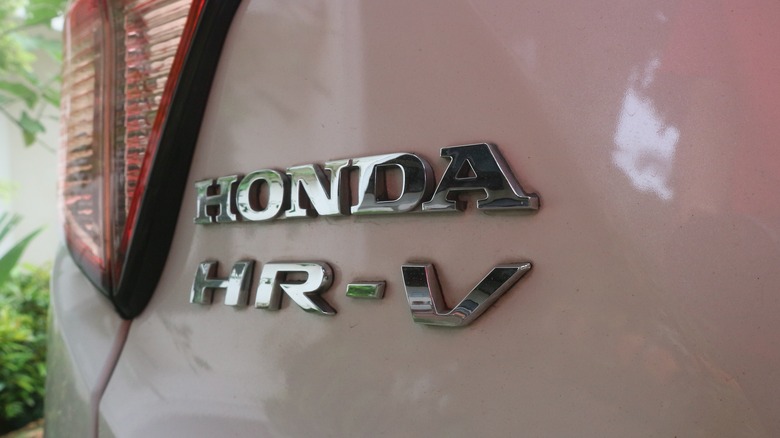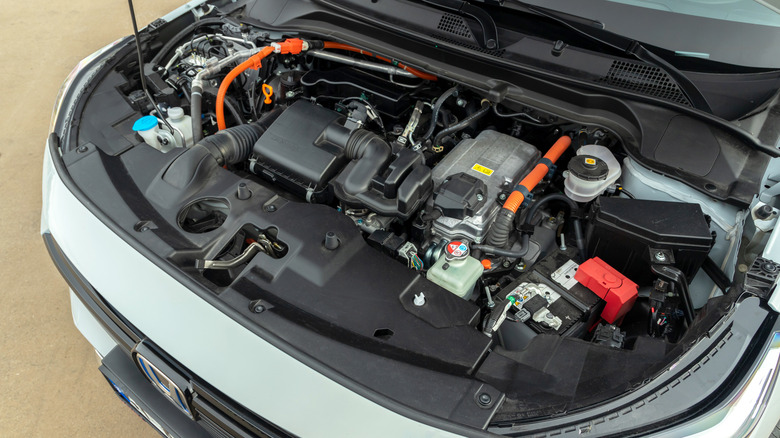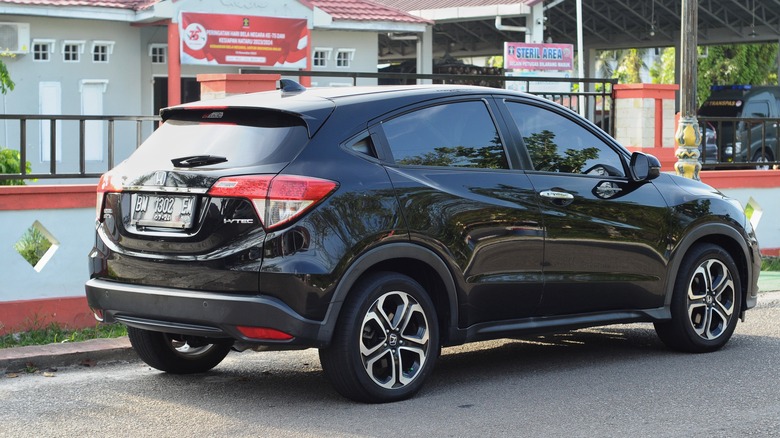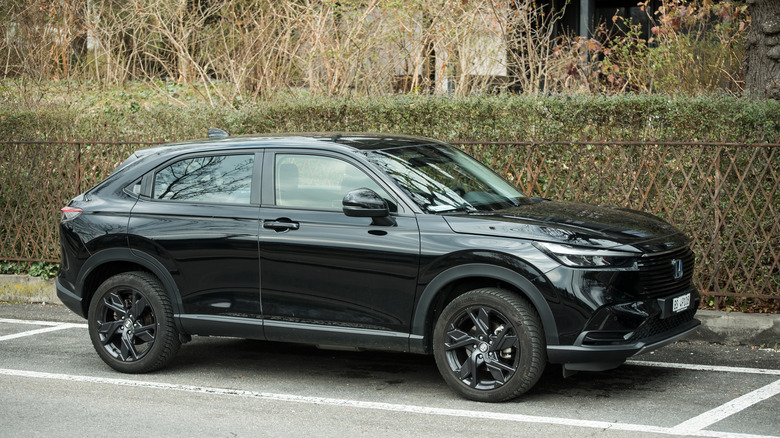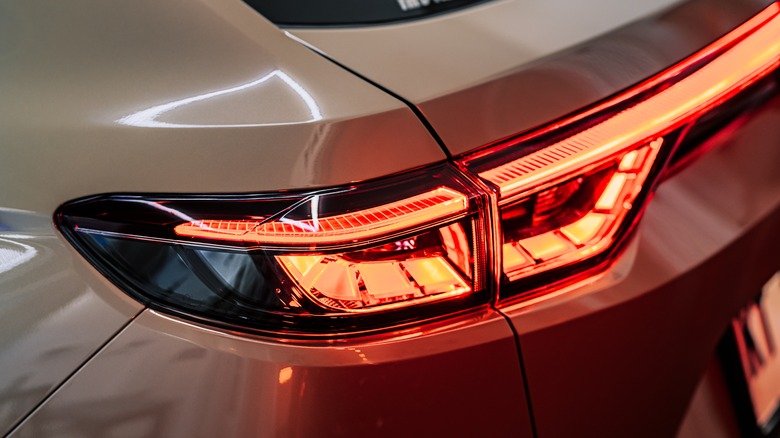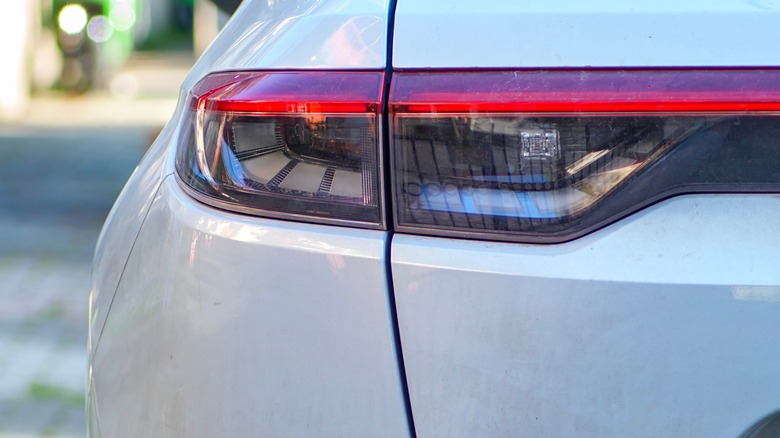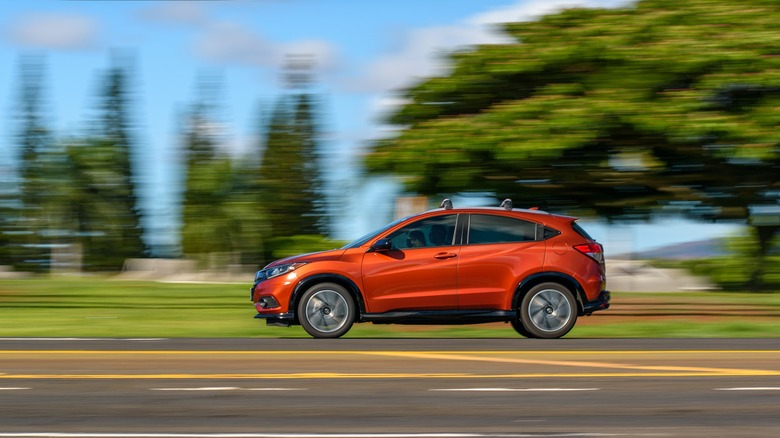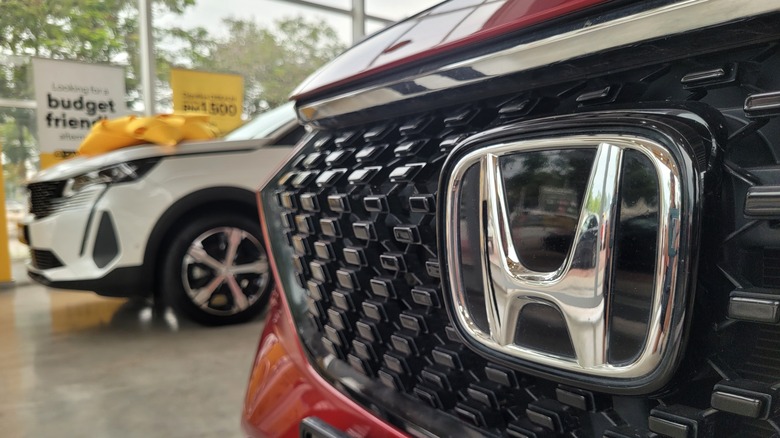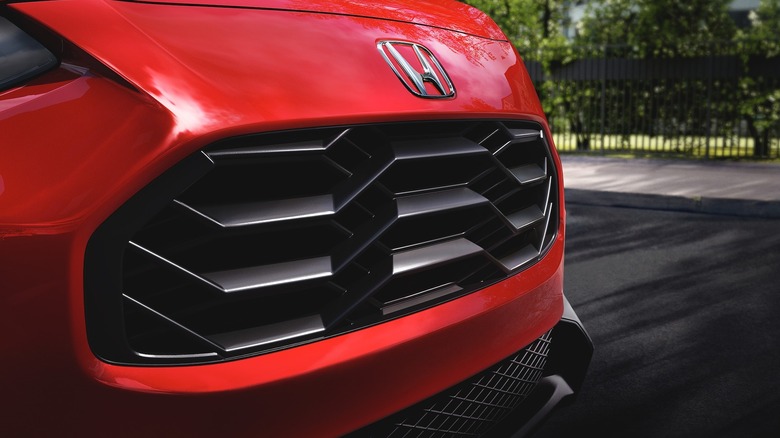Common Problems Reported By Honda HR-V Owners
For a compact crossover, the Honda HR-V is pretty impressive. It's relatively affordable — the MSRP on a 2026 HR-V starts around $26,000 — and gets decent gas mileage. Leather details, thoughtful ergonomics, and space for five help the HR-V appeal to a variety of drivers. Some fun color options round out the package, although it'll cost a bit extra for the premium selections.
Yet not everything about the HR-V is praiseworthy. In fact, HR-V might mean Hi-Rider Revolutionary Vehicle, but consumers who drive them might disagree with the 'revolutionary' bit. Despite all Honda's accomplishments, the HR-V does not appear to be perfectly refined just yet.
Like any vehicle, the HR-V appears to be plagued by a host of common problems, including some that sound pretty scary, based on drivers' firsthand accounts. Starting with the most frequently reported issues that drivers have complained about through the National Highway Traffic Safety Administration (NHTSA), we've compiled a list of common problems affecting HR-V owners. We're focusing on the most frequently reported issues with newer vehicles (less than 10 years old) as reported by the NHTSA. Stay tuned after the list for more on our methodology.
Shattered windows
One major and scary issue with the Honda HR-V across multiple model years is the fact that the windows can apparently self-annihilate. Many consumers report random, catastrophic window-shattering events under a range of conditions, all with no known provocation. While some drivers reported that the windows were hot to the touch prior to shattering (sometimes while the rear defroster, for example, was on), others have gone out to their garage or parking space in all manner of weather and experienced the same breakage.
Moreover, many drivers have experienced their windows — from the windshield to the side windows, and most commonly, the rear window — shattering while driving on city streets or highways. The 2023 HR-V has the most complaints, but it appears to have happened with various years, based on reports documented by the NHTSA.
While the HR-V is quite different from the CR-V, the latter has also received numerous reports of shattered windows and sunroofs. Specifically, the 2017 CR-V has many documented reports of unexplained glass explosions. While Honda hasn't issued a recall for the HR-V, it has stated that a manufacturing defect may allow for the development of a hot spot that results in glass catastrophes and is offering a service campaign to remedy the issue.
Windshield (and window) cracks
Unfortunately for Honda HR-V owners, the glass issues don't seem to be limited to the rear window or defroster malfunction. Rather, many HR-V owners have reported miscellaneous cracks on windshields and side windows. When the windows don't spontaneously break, they sometimes seem to develop unexplainable cracks, according to owners of 2023 HR-Vs. Severe cracking has significantly impacted many drivers' ability to operate their vehicles safely, according to reports documented by the NHTSA.
Based on some consumer reports, such as one driver who noticed a softball-sized hole in their rear window, cracks in the glass later led to breakage. However, others suggest that the cracks, particularly those in the front windshield, cropped up with no prior indication. Drivers have also reported other problems with their windshield glass, such as distortion when looking through certain sections.
While the 2023 HR-V appeared to have the most reported cracking issues among the models we examined (2016 and newer), fewer problems occurred with models like the 2019 HR-V. If you plan to purchase a newer HR-V, skipping the 2023 could be your best bet as far as avoiding windshield cracks and rear windows (or sunroofs) failing. However, it's essential to check for manufacturer communications and recalls, as well as examine your HR-V for damage regularly, just in case.
Loss of engine power
The 2023 Honda HR-V seemed appealing when SlashGear reviewed it, but that doesn't mean it's without its faults. With an affordable price tag and new features and tech added, the only real complaint was some cabin noise and an exterior design that isn't pleasing to everyone's eye. That said, it turns out that the 2023 HR-V had some issues that didn't present themselves during the review.
If glass randomly breaking while on the freeway isn't bad enough (for those consumers who have experienced it), how about completely losing electrical power? In another strike against the HR-V, many consumers reported such power issues with their 2023 HR-Vs, noting that in many cases, their vehicles simply died while navigating the freeway. Some report needing to jump-start the vehicle after finding it dead first thing in the morning, and the issue isn't limited to specific model years.
Some owners of 2022 HR-Vs also reported issues that were documented by the NHTSA. Drivers reported finding their vehicles inexplicably dead. Other times, the vehicle would die while driving, and it was a gamble whether or not it would restart. In some scarier incidents, drivers reported that their vehicles decelerated on the freeway, sometimes resulting in accidents with severe injuries.
Instrument panel problems
Another frequently reported issue among various model years of the HR-V is problems with the instrument panel. While the issue sometimes appears to be connected to power loss problems (according to drivers who also dealt with their vehicles shutting off without warning), other times, gibberish on the dashboard is the first indicator of a problem, according to some owners of 2016 HR-Vs.
Others, such as drivers of 2022 HR-Vs, report that all the sensor warning lights come on at once, and include discrepancies like the fuel light coming on when the gas tank is full. While those drivers sometimes report power failures as well, the warning light issue sometimes stands alone. Further, some drivers suggest that temperature plays a part in the instrument panel going dark or, conversely, lighting up incorrectly. Thus, when the vehicle warms up, reported one owner, the issue subsides.
According to NHTSA records for various model years, no recalls have been issued for the instrument panel issue reported by various consumers. For the 2023 HR-V, which is the most-complained-about model year according to the NHTSA, no manufacturer notices have been posted regarding this issue, either. Some consumers reported that a visit to the dealership remedied their issue, so it's possible that a software fix serves as a simple solution.
Push to start doesn't start
Along with various complaints about HR-Vs inexplicably losing power or failing to start, some consumers have also reported that their push-to-start HR-Vs don't actually start via the button function. Specifically, owners of 2016 model years seem to have struggles with getting the button to work, noting that it can take multiple tries to actually start the vehicle.
The issue appears to be pervasive, affecting multiple model years. In 2020, Honda released a service bulletin notifying consumers of a warranty extension for the keyless start system in its HR-Vs. The bulletin applies to 2016-2018 models with specific hardware. One specific part — the Engine Stop/Start Switch — requires replacement to fix the problem, according to Honda's repair procedure, so this is one concern that consumers should be able to get resolved quickly on their used HR-Vs.
As with any other vehicle issue, consumers can use their car's VIN to determine whether recalls or manufacturer communications involve their HR-V, by way of the NHTSA search tool or through Honda's recall lookup tool. Ideally, HR-V owners will have many of the reported issues repaired before they experience problems.
Sticky steering
The 2023 HR-V might be one used Honda to steer clear of due to the common problems already mentioned, but it turns out there's more than just catastrophic failures to worry about. Case in point? Consumers report sticky steering that makes driving an HR-V downright obnoxious.
Some drivers of 2023 and 2024 HR-Vs report their steering wheels being unresponsive or resistant when trying to steer. Various accounts of steering issues on roadways suggest that the problem could be dangerous due to the fact that you have to apply pressure to overcome the stickiness, which then results in having to lane correct after unsticking the wheel.
Honda has released an advisory regarding a steering issue that includes 2023 and 2024 model years across all trim levels. Unfortunately for consumers, it appears that the parts aren't always readily available when repairs are needed, according to complaints. In an apparently separate issue, Honda also recalled over 1.6 million models — including HR-Vs — for steering gearbox damage. The recall notes that a manufacturing issue could lead to undue wear on the steering gearbox, causing difficulty steering. Either way, consumers have a fix for sticky steering complaints, but it might take time to get the repairs completed.
No available parts for the recall repair
A common problem reported by HR-V owners across various model years is that fixes aren't always easy. Though Honda may issue a manufacturer communication or recall, many consumers — including 2023 and 2024 HR-V owners — report that they had a difficult time getting their SUV into the shop for repairs.
Though not every HR-V experiences the issues covered in bulletins or recalls, Honda does notify owners when their vehicles are eligible for fixes. However, various consumer accounts suggest that the time it takes to get the recommended work done is excessive, with various dealers not having the appropriate equipment or parts to handle the issue. Some reports to the NHTSA include a side note that the required parts were on backorder, while others involve consumers who are upset due to what they perceive as unreasonable waiting times.
Depending on the size of a recall (recalls can impact millions of vehicles, and multiple models within a brand), consumers might be waiting for a while for HR-V fixes. Hopefully, not every HR-V owner will experience every common problem, or they might wind up in the shop more often than not.
Failed camera display
Not every problem commonly reported by HR-V owners poses an immediate threat to their safety or makes driving difficult. Some equipment failures are merely inconveniences, but that doesn't mean drivers don't want the problems addressed. One such example is that failed camera sensors render it impossible for HR-V owners to use their backup cameras.
Unfortunately, for owners of 2019-2022 Honda HR-Vs, the rearview camera display appears to be commonly faulty. Honda's corporate release about the issue specified that over 100,000 vehicles (both HR-Vs and Fits) had a defect that resulted in the camera display failing. It's unclear whether consumer complaints spurred the manufacturer communication, or if Honda was aware of the problem upon manufacture, but at least this issue hasn't resulted in a long list of incidents reported to the NHTSA.
Honda's explanation is that the power circuit in the display unit wasn't designed correctly, so that when the engine starts, the display doesn't boot up properly. While the camera might be working just fine, the display doesn't work at all. For this one, however, the fix is relatively simple. A software update promises to resolve the bootup problem, making your backup camera functional again.
Faulty forward collision avoidance
Many Honda models feature Honda Sensing, technology that aims to make driving safer. The feature involves multiple cameras and sensors that monitor the area around (and in front of) your car. Honda Sensing can do things like notify you of speed limits, alert you to vehicles or objects in your blind spots, and even sound a warning if you begin to drift out of your lane. The only problem with the feature appears to be when it malfunctions, and according to HR-V owners, that is not an uncommon problem.
Drivers of 2019 HR-Vs, specifically, have reported problems with the forward collision avoidance function in their vehicles. For some drivers, the issue was as simple as incorrect alerts popping up when there were actually no hazards. For others, the warning lights didn't work at all. It seemed as if the Honda Sensing shut down entirely with no warning. Still other drivers report that their sensors seem to malfunction and apply the brakes for no reason when the roadway is clear.
While the collision avoidance problem appears to be distinct from the power loss issue reported with some HR-Vs, the random braking and warning lights can have a similar effect, causing vehicles to stall in hazardous situations.
Distorted backup camera view
In yet another backup camera issue, HR-V drivers report that their cameras become distorted in different weather conditions. Though this could, in theory, happen with any backup camera, various consumers driving 2018 and other HR-V model years report having trouble using their cameras when it's cold, wet, or dusty. One Honda dealership addressed the issue of visibility concerns in rainy conditions, pointing out that water accumulating on the camera lens can make the view on the screen blurry or obscured.
Moisture can also get into the camera housing, causing long-term issues that continue long after the rain stops. Honda appears to recommend a range of solutions, from protective coating on the camera to, more simply, regular cleaning of the lens. Adjusting the camera angle could also help drivers get a better backup view.
However, some consumers point out that their backup cameras don't work at night. Rather than any type of night vision function, the HR-V backup camera might show a snowy, blizzard-looking view of nighttime conditions, according to drivers. Light sensitivity on the camera depends on the model year, and the other known issues with HR-V camera displays could also impact visibility.
Tail lights filled with water
In the same vein as the window defroster problems and camera lens visibility issues, not every part of the HR-V seems to be resistant to weather conditions. While cold weather apparently didn't mix with many HR-V drivers' rear windows, it seems the tail lights don't do well in wet conditions. The issue has been reported by drivers of various years of HR-Vs, including the 2016 version, and is a highly viewed query in HR-V forums.
The NHTSA has documented various complaints about rear lights filling with water, and some consumers also report the rear trunk filling with water. Although there doesn't seem to be an official fix from Honda, consumers appear to agree that replacing the gaskets on the tail lights is a reliable solution to the fog and moisture issue. However, depending on the severity of the issue, you may need to replace the entire tail light assembly.
Some drivers take a DIY approach with switching gaskets and even drilling holes in the tail light assembly's lowest point, which is probably not advisable. In some cases, drivers report taking their HR-Vs to the dealership for repairs, which is perhaps the simplest, if not the most cost-effective, solution.
Random annoying noises
You may recall reading in SlashGear's review of the 2023 HR-V that it had quite a bit of cabin noise during test drives. Most of the noise was due to the CVT, or Continuously Variable Transmission, something that consumers have also apparently noticed. The audible hum can be distracting to some drivers and is often mentioned in owner reports.
Complaints about noise in the 2023 HR-V were also cited by Consumer Reports, which reported issues ranging from squeaking and rattling to scraping. Worse, according to NHTSA records, some consumers reported transmission failures following the escalation of annoying noises. In short, a noise could be nothing, or it could be something very serious, and with the HR-V, it could be hard to tell.
With so many problems reported by other drivers, you might start to wince at every sound your HR-V makes, whether there's a serious issue behind it or not. If you do hear excessive transmission noise, it might be wise to visit your mechanic and, according to some drivers, have your CVT transmission belt checked for potential failures. The issue appears to be taken seriously by Honda, with the manufacturer releasing at least one communication regarding warranty extension on CVT drive belts.
Airbag deployment failure
While airbag deployment failures, thankfully, seem to be a lesser-reported Honda HR-V problem, they do happen. Specifically in model years 2016 and 2019, drivers reported two types of airbag problems. One is the lack of airbag deployment in severe accidents. For example, one driver of a 2016 HR-V reported that despite applying the brakes (another issue they were experiencing), their vehicle slammed into the vehicle ahead at 50 MPH, and no airbags deployed anywhere in the vehicle.
In another incident documented by the NHTSA, a consumer reported that their HR-V decelerated on the freeway, after which they were hit and pushed into a barrier. The vehicle's airbags did not deploy, and the driver sustained serious injuries. The vehicle was also totaled. Though this example is on the extreme end of the various reports documented by the NHTSA, it's intimidating to anyone shopping for (or already driving) an HR-V. Other similar incidents have also been documented in NHTSA records.
There are also numerous reports of indicator lights for airbags malfunctioning. It's not clear whether the indicator light issues are tied to the airbags failing to deploy, but if your HR-V has sensor issues, it's probably worth getting the vehicle checked out by Honda.
Methodology
To develop our list of the most common problems reported by Honda HR-V owners, we went to the National Highway Traffic Safety Administration (NHTSA) and searched for all years of Honda HR-Vs. Then, we looked at the model years with the most reported consumer complaints. While there may still be some older models on the road, we honed in on vehicles from 2016 forward. From there, we checked each model's specific complaint categories, reporting on the most prolific ones.
Despite various problems, the HR-V is still on the market, and we found no statistical evidence that an HR-V is more dangerous than any other vehicle on the road. However, Honda does have new 2025 models that may improve upon past years' problems. There's also a 2026 HR-V that promises new features, so hopefully it comes with fewer consumer complaints.
